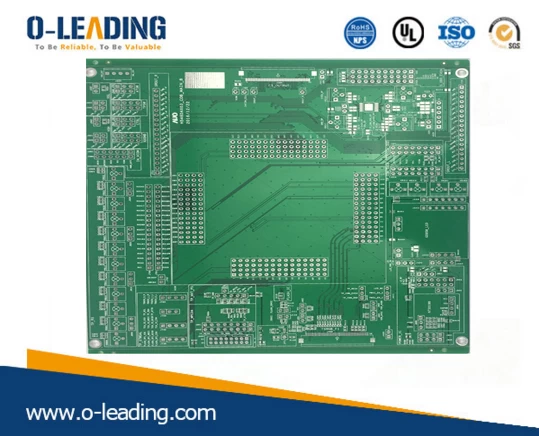PCB failure analysis technology (2)
Microscopic infrared analysis
Micro-infrared analysis is an analysis method that combines infrared spectrum with a microscope. It uses the principle of different absorption of infrared spectrum by different materials (mainly organic substances), analyzes the compound composition of materials, and combines the microscope to make visible and infrared light the same The optical path, as long as it is in the visible field of view, can find trace organic pollutants to be analyzed. Without the combination of a microscope, usually the infrared spectrum can only analyze samples with a large sample volume. In many cases in the electronic process, trace pollution can lead to poor solderability of the PCB pads or lead pins. It is conceivable that it is difficult to solve the process problem without the infrared spectrum of the microscope. The main purpose of micro-infrared analysis is to analyze the organic pollutants on the welded surface or the surface of the joint, and to analyze the cause of corrosion or poor solderability.

Scanning electron microscope analysis
Scanning electron microscope (SEM) is one of the most useful large-scale electron microscopy imaging systems for failure analysis. Its working principle is to use the electron beam emitted by the cathode to be accelerated by the anode and focused by a magnetic lens to form a beam with a diameter of several tens to Under the deflection of the scanning coil, the electron beam current of several thousand angstroms (A) makes a point-by-point scanning movement on the sample surface in a certain time and space sequence. This high-energy electron beam will be excited when it is bombarded on the sample surface. A variety of information is produced, and various corresponding graphics can be obtained from the display screen after being collected and enlarged. Excited secondary electrons are generated in the range of 5-10 nm on the sample surface. Therefore, secondary electrons can better reflect the morphology of the sample surface, so they are most commonly used for morphological observation; and excited backscattered electrons are generated on the sample surface. In the range of 100 ~ 1000nm, different characteristics of backscattered electrons are emitted as the atomic number of the material is different. Therefore, the backscattered electron image has morphological features and the ability to discriminate the atomic number. Therefore, the backscattered electron image can reflect chemical elements Distribution of ingredients. The current scanning electron microscope is very powerful, and any fine structure or surface feature can be enlarged to hundreds of thousands of times for observation and analysis.
In terms of failure analysis of PCBs or solder joints, SEM is mainly used to analyze the failure mechanism. Specifically, it is used to observe the morphology of the surface of the pads, the metallographic structure of the solder joints, the measurement of intermetallics, and the solderable coating. Analysis and measurement of tin whisker. Unlike optical microscopes, scanning electron microscopy is an electronic image, so there are only black and white colors, and the sample of the scanning electron microscope needs to be conductive, and non-conductors and some semiconductors need to be sprayed with gold or carbon, otherwise the accumulation of charge on the surface of the sample will affect Observation of the sample. In addition, the depth of field of the SEM image is much larger than that of the optical microscope, and it is an important analysis method for uneven samples such as metallographic structure, micro fracture and tin whisker.

X-ray energy spectrum analysis
The SEMs mentioned above are generally equipped with X-ray spectrometers. When a high-energy electron beam hits the sample surface, the inner electrons in the atoms of the surface material are bombarded and escaped. When the outer electrons transition to a low energy level, characteristic X-rays are excited, and the characteristics of the different atomic energy levels of different elements are emitted. X-rays are different, so characteristic X-rays emitted from a sample can be analyzed as a chemical composition. At the same time, according to the detection of X-ray signals as characteristic wavelengths or characteristic energies, the corresponding instruments are called spectroscopic dispersive spectrometer (abbreviated as spectrometer, WDS) and energy dispersive spectrometer (abbreviated as energy spectrometer, EDS). The resolution of the spectrometer is Higher than the spectrometer, the analysis speed of the spectrometer is faster than the spectrometer. Due to the fast speed and low cost of the energy spectrometer, the general SEM is configured with an energy spectrometer.

With the different scanning methods of the electron beam, the spectrometer can perform surface point analysis, line analysis, and surface analysis, and can obtain information on different element distributions. Point analysis obtains all elements of a point; line analysis performs one element analysis on a specified line at a time, and multiple scans obtain line distributions of all elements; area analysis analyzes all elements in a specified surface, and the measured element content is The average of the measurement area range.
In the analysis of PCBs, the energy spectrometer is mainly used for the component analysis of the surface of the pad, and the element analysis of the contamination on the surface of the pad and the lead pin with poor solderability. The accuracy of the quantitative analysis of the energy spectrometer is limited, and the content below 0.1% is generally not easy to detect. The combination of energy spectroscopy and SEM can simultaneously obtain surface morphology and composition information, which is why they are widely used.
































